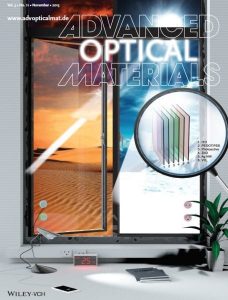 The latest issue of Advanced Optical Materials is now available. You can sign up to access all Advanced Optical Materials articles right here!
The latest issue of Advanced Optical Materials is now available. You can sign up to access all Advanced Optical Materials articles right here!
These articles were highlighted on the covers of the Advanced Optical Materials November issue:
Smart Windows
A smart photovoltaic window is fabricated by Y. Gao, C. J. Brabec, and co-workers by solution-depositing a thermochromic VO2 layer on top of a semitransparent organic solar cell. The front cover shows how the window only produces electricity using the visible part of the solar spectrum, and saves energy via intelligently modulating the amount of NIR radiation passing through the window in response to ambient temperature. When the outdoor temperature is higher than the phase transition temperature of the VO2, it blocks part of the NIR spectrum, reducing energy consumption from air conditioning. In cold weather, it allows significant NIR to pass through, reducing energy consumption from heating.

Detectors
This inside cover illustrates reed membranes utilized by J. Wu and L. Y. Lin to fabricate flexible UV photodetectors with ZnO nanocrystals embedded. The short-circuit problem, often seen when using nonuniform material deposition methods commonly employed in flexible devices, can be easily avoided with the membrane as the interspacing layer, thus facilitating the fabrication process. The device can achieve over 3% EQE at 350 nm wavelength, and over 1% in general near-UV range.
 Catalysis
Catalysis
T. J. Antosiewicz, C. Wadell, and C. Langhammer show on the back cover how silver nanodisk-shaped optical antennas harvest energy from an incident light beam via excitation of localized surface plasmons. The energy of the plasmon is then coupled into adjacent much smaller palladium nanoparticles, increasing their light absorption by more than an order of magnitude on average. It is expected that this energy transfer pathway can be exploited to increase hot electron-mediated catalytic reaction rates on small transition metal nanoparticles.

















